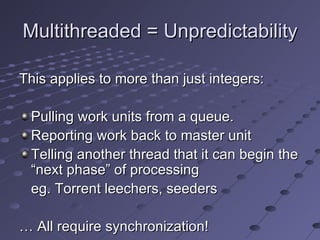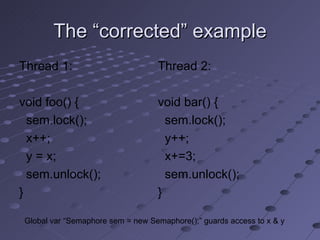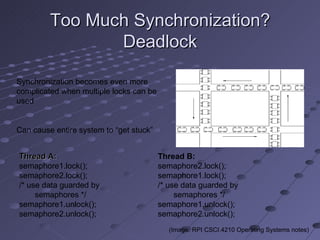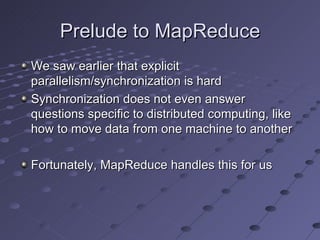Distributed computing presentation
- 1. Distributed Computing … and introduction of Hadoop - Ankit Minocha
- 2. Outline Introduction to Distributed Computing Parallel vs Distributed Computing.
- 3. Computer Speedup Moore’s Law: “ The density of transistors on a chip doubles every 18 months, for the same cost” (1965)
- 4. Scope of problems What can you do with 1 computer? What can you do with 100 computers? What can you do with an entire data center?
- 5. Rendering multiple frames of high-quality animation
- 6. Parallelization Idea Parallelization is “easy” if processing can be cleanly split into n units:
- 7. Parallelization Idea (2) In a parallel computation, we would like to have as many threads as we have processors. e.g., a four-processor computer would be able to run four threads at the same time.
- 10. Parallelization Pitfalls But this model is too simple! How do we assign work units to worker threads? What if we have more work units than threads? How do we aggregate the results at the end? How do we know all the workers have finished? What if the work cannot be divided into completely separate tasks? What is the common theme of all of these problems?
- 11. Parallelization Pitfalls (2) Each of these problems represents a point at which multiple threads must communicate with one another, or access a shared resource. Golden rule: Any memory that can be used by multiple threads must have an associated synchronization system !
- 12. What is Wrong With This? Thread 1: void foo() { x++; y = x; } Thread 2: void bar() { y++; x+=3; } If the initial state is y = 0, x = 6, what happens after these threads finish running?
- 13. Multithreaded = Unpredictability When we run a multithreaded program, we don’t know what order threads run in, nor do we know when they will interrupt one another. Thread 1: void foo() { eax = mem[x]; inc eax; mem[x] = eax; ebx = mem[x]; mem[y] = ebx; } Thread 2: void bar() { eax = mem[y]; inc eax; mem[y] = eax; eax = mem[x]; add eax, 3; mem[x] = eax; } Many things that look like “one step” operations actually take several steps under the hood:
- 14. Multithreaded = Unpredictability This applies to more than just integers: Pulling work units from a queue. Reporting work back to master unit Telling another thread that it can begin the “next phase” of processing eg. Torrent leechers, seeders … All require synchronization!
- 15. Synchronization Primitives A synchronization primitive is a special shared variable that guarantees that it can only be accessed atomically . Hardware support guarantees that operations on synchronization primitives only ever take one step
- 16. Semaphores A semaphore is a flag that can be raised or lowered in one step Semaphores were flags that railroad engineers would use when entering a shared track Only one side of the semaphore can ever be red! (Can both be green?)
- 17. Semaphores set() and reset() can be thought of as lock() and unlock() Calls to lock() when the semaphore is already locked cause the thread to block . Pitfalls: Must “bind” semaphores to particular objects; must remember to unlock correctly
- 18. The “corrected” example Thread 1: void foo() { sem.lock(); x++; y = x; sem.unlock(); } Thread 2: void bar() { sem.lock(); y++; x+=3; sem.unlock(); } Global var “Semaphore sem = new Semaphore();” guards access to x & y
- 19. Condition Variables A condition variable notifies threads that a particular condition has been met Inform another thread that a queue now contains elements to pull from (or that it’s empty – request more elements!) Pitfall: What if nobody’s listening?
- 20. The final example Thread 1: void foo() { sem.lock(); x++; y = x; fooDone = true; sem.unlock(); fooFinishedCV.notify(); } Thread 2: void bar() { sem.lock(); if(!fooDone) fooFinishedCV.wait(sem); y++; x+=3; sem.unlock(); } Global vars: Semaphore sem = new Semaphore(); ConditionVar fooFinishedCV = new ConditionVar(); boolean fooDone = false;
- 21. Too Much Synchronization? Deadlock Synchronization becomes even more complicated when multiple locks can be used Can cause entire system to “get stuck” Thread A: semaphore1.lock(); semaphore2.lock(); /* use data guarded by semaphores */ semaphore1.unlock(); semaphore2.unlock(); Thread B: semaphore2.lock(); semaphore1.lock(); /* use data guarded by semaphores */ semaphore1.unlock(); semaphore2.unlock(); (Image: RPI CSCI.4210 Operating Systems notes)
- 22. The Moral: Be Careful! Synchronization is hard Need to consider all possible shared state Must keep locks organized and use them consistently and correctly Knowing there are bugs may be tricky; fixing them can be even worse! Keeping shared state to a minimum reduces total system complexity
- 23. Hadoop to the rescue!
- 24. Prelude to MapReduce We saw earlier that explicit parallelism/synchronization is hard Synchronization does not even answer questions specific to distributed computing, like how to move data from one machine to another Fortunately, MapReduce handles this for us
- 25. Prelude to MapReduce MapReduce is a paradigm designed by Google for making a subset (albeit a large one) of distributed problems easier to code Automates data distribution & result aggregation Restricts the ways data can interact to eliminate locks (no shared state = no locks!)
- 26. Thank you so much “Clickable” for your sincere efforts.
Editor's Notes
- #13: There are multiple possible final states. Y is definitely a problem, because we don’t know if it will be “1” or “7”… but X can also be 7, 10, or 11!
- #14: Inform students that the term we want here is “race condition”
- #19: Ask: are there still any problems? (Yes – we still have two possible outcomes. We want some other system that allows us to serialize access on an event.)
- #20: Go over wait() / notify() / broadcast() --- must be combined with a semaphore!






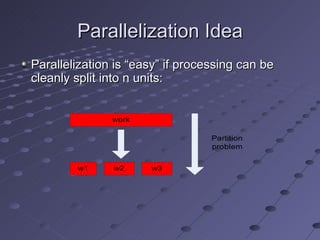





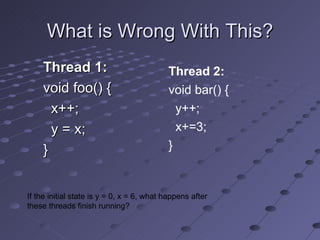
![Multithreaded = Unpredictability When we run a multithreaded program, we don’t know what order threads run in, nor do we know when they will interrupt one another. Thread 1: void foo() { eax = mem[x]; inc eax; mem[x] = eax; ebx = mem[x]; mem[y] = ebx; } Thread 2: void bar() { eax = mem[y]; inc eax; mem[y] = eax; eax = mem[x]; add eax, 3; mem[x] = eax; } Many things that look like “one step” operations actually take several steps under the hood:](https://image.slidesharecdn.com/distributedcomputingpresentation-110910130102-phpapp01/85/Distributed-computing-presentation-13-320.jpg)
